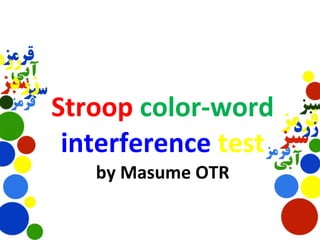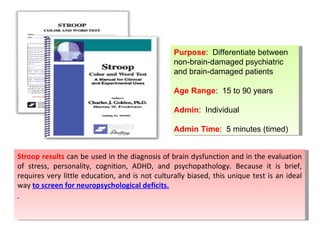- 1. Stroop color-word interference test by Masume OTR
- 2. Purpose : Differentiate between non-brain-damaged psychiatric and brain-damaged patients Age Range : 15 to 90 years Admin : Individual Admin Time : 5 minutes (timed) Stroop results can be used in the diagnosis of brain dysfunction and in the evaluation of stress, personality, cognition, ADHD, and psychopathology. Because it is brief, requires very little education, and is not culturally biased, this unique test is an ideal way to screen for neuropsychological deficits.
- 3. Stroop test Designed by John Ridley Stroop Selective attention , cognitive flexibility , Switching , inhibition 2phases: Congruent and interference conditions
- 4. Procedure-Trial phase: V B N M
- 5. Procedure-Trial phase: V B N M
- 6. Procedure-Trial phase: V B N M
- 7. Procedure-Trial phase: V B N M
- 8. Procedure- congruent condition: سبز V B N M
- 9. Procedure- congruent condition: آبی V B N M
- 10. Procedure- congruent condition: قرمز V B N M
- 11. Procedure- congruent condition: زرد V B N M
- 12. Procedure- interference condition: زرد V B N M
- 13. Procedure- interference condition: قرمز V B N M
- 14. Procedure- interference condition: سبز V B N M
- 15. Procedure- interference condition: آبی V B N M
- 16. Scoring : Trial time (s) Errors Missed responses Reaction time (ms) Interference score true responses in congruent condition - true responses in interference condition
- 17. Stroop, time recorded time Stimulus appeared Response Each stimulus lasts for 2000 ms ---- Reaction time ----- Inter-stimuli time 800 ms
- 18. Sample score sheet: congruent Interference Trial time (s) زمان آزمایش Reaction time (ms) زمان واکنش زمان واکنش بالاتر شانگر بازداری کمتر است Errors تعداد خطاها تعداد صحیح corrects 12 11 No response تعداد بدون پاسخ Interference score نمره تداخل نمره تداخل = نمره تعداد همخوان درست – تعداد ناهمخوان درست 1 نمره تداخل نشانگر کنترل توسط فرد است
- 19.
- 20.
- 21. Executive Functioning (EF)
- 22. Executive functions – what are they? If you were to ask three psychologists for a definition of ‘executive function most would agree it centres around our ability to control our thoughts and actions in order to respond flexibly to our environment. In other words, all the abilities that enable a person to analyse what they want, how they might get it, and then carry that plan out, often over long periods of time. Executive functions differ from many other functions in the brain in that they do not appear to be dedicated to a specific task (such as moving a finger or processing sound). Instead, the frontal regions of the brain that play a role in all executive functions are available to make new associations, engage in planning, make decisions and inhibit impulses – mental processes that free an organism up from responding only to an immediate situation. It is also widely accepted that executive functions play a critical part in complex social behaviour.
- 23. Measures such as the Stroop Color–Word Interference Test were not originally designed to be used as clinical measures (Burgess et al., 2006). These instruments later found their way into the clinical realm and have been used to help predict difficulties with everyday functioning primarily based on the assumption that they assess functions/constructs that are important to carrying out real-world activities. As an example , with regard to the Stroop, one might hypothesize that the ability to inhibit an automatic , overlearned response would, at times, be beneficial to the safe driving of an automobile, such as being able to withhold a reflex to press the brakes if a traffic light turns red when the driver is halfway through the intersection.
- 24. The Stroop Test is of interest in evaluating resistance to cognitive interference .
- 25. THE STROOP TEST The test is based on the Stroop effect and consists of asking the subject to respond to only one of the parts of which the stimulus is made up, inhibiting the response to the other part . The subject is shown the name of a colour written in a colour different from the colour named and asked to say the name of the colour in which the word is written . For example, the subject may be shown the word RED قرمز written in green and the subject must respond by saying GREEN . The subject must therefore inhibit the reading process and activate the colour recognition process . Different authors have shown with neuroimaging techniques that the right frontal regions , in particular the right anterior cingulate gyrus (zones 23, 24, 32) and the right orbital zones (10 and 47), are involved during the Stroop Test (Bench et al., 1983; Pardo et al., 1990).
- 26. A final example of an early screening test for attentional difficulties is the Stroop procedur e (A. R. Jensen & Rohwer, 1966; Stroop, 1935). کتاب مارنات فصل 14 صفحه 1030
- 27. Response Inhibition : It Starts with Stopping Russell Barkley, Ph.D has created the response inhibition theory,that places primary emphasis on response inhibition—that is, the ability to hold back a response . humans are able to pause and think through the various response options and then choose the best one. It’s an almost invisible information processing that happens in a split second. An example is almost subconsciously deciding to ignore the sound of someone dropping a pen while you’re working at your computer (i.e., not getting distracted ), or holding your thought to what someone is saying until she finishes talking (i.e., not impulsively interrupting ).
- 28. neurophysiological studies have pointed to certain parts of the brain being involved in selective attention , Particularly the extrastriate visual cortex and the parietal lobes . Evidence of selective attention deficits was then discussed for two conditions in which such deficits have often been hypothesized, Alzheimer’s disease and schizophrenia . Other conditions were then considered, including closed head injury and stroke . A phenomenon that occurs in the latter condition, unilateral negle ct.
- 29. توجه پايدار و بازداري پاسخ در كودكان مبتلا به نارسايي توجه / فزون كنشي در مقايسه با كودكان عادي توجه متمركز يا انتخابي، نشان دهنده ي توان فرد براي جلوگيري از حواس پرتي ( بازداري تداخل ) به منظور تمركز دادن توجه به محرك ( هاي ) هدف است در مقابل، توجه پايدار توانايي نگه داشت توجه متمركز در طول زمان مي باشد به اين ترتيب، به نظر ميرسد همان گونه كه باركلي اظهار مي كند هم توجه انتخابي و هم توجه پايدار به توان فرد براي بازداري تداخل و حتي انواع ديگر بازداري بستگي داشته باشند .
- 30. اثر تداخل باعث می شود عملکرد افراد در سرعت نامیدن کلمات ناهمخوان نسبت به همخوان کاهش پیدا کند . اعتبار این آزمون استروپ در بازآزمایی از 0.81 تا 0.91 درصد گزارش شده است .
- 31. Selective attention typically involves searching for a target item amongst a display of distracter items. The Stroop task, however , involves attending to a particular feature of a stimulus while trying to ignore a second feature of the same stimulus. If the stimulus happens to be a word, then the word itself proves difficult to ignore, and we have to work hard to inhibit this tendency. Thus the Stroop is more usually seen as a test of inhibition , One theory of frontal lobe function (Fuster, 1989) suggests that the frontal lobes perform several key processes. The first, according to Fuster, is to inhibit behaviours and control interference.
- 32.
- 33. Improving the ecological validity of executive functioning assessment Naomi Chaytor a,b,∗, Maureen Schmitter-Edgecombe a, Robert Burr c a Washington State University, Department of Psychology, Pullman, WA, United States b Baylor College of Medicine, Department of Neurosurgery, Houston, TX, United States c Sacred Heart Medical Center, Neuropsychology Program, Spokane, WA, United States Accepted 13 December 2005 It is assumed that the impaired brain processes, which lead to poor performance on a neuropsychological test, will also lead to poor performance in other situations outside the test situation . In other words, it is assumed that neuropsychological tests have ecological validity. Despite study differences, even in those studies that have reported favorable ecological validity, the magnitude of the relationships tended to be moderate, ranging from .27 to .65, when significant. This means that a large amount of the variance in everyday executive skills remains unaccounted for.
- 34. many characteristics of traditional neuropsychological assessment can pose problems for ecological validity research , effectively placing a limit on the amount of variance in everyday skills that can be accounted for by neuropsychological testing. These characteristics include the nature of the testing environment , incomplete agreement on what constructs the tests measure , the small sample of behavior observed during testing , and the inability to use compensatory strategies. There are also several noncognitive factors that can influence the relationship between test performance and everyday performance. These noncognitive factors include emotional problems , level of premorbid functioning , motor functioning , health problems , and varying environmental cognitive demands (Long & Kibby; Sbordone, 1997). The cognitive deficit and the environment interact to produce behavior, and therefore both need to be assessed if ecological validity is to be demonstrated (Chelune, 1985; Goldstein, 1996; Heinrichs, 1990)
- 35. In this study, Trails B and the Stroop Color–Word score were found to have the highest ecological validity, while the WCST perseverative errors was not related to everyday executive functioning. It should be noted that both the Trails B and Stroop Color–Word score involve speeded processing in addition to executive functioning , which may partially account for the higher Ecological validity of these two tasks . As a whole, the current set of commonly used executive tests failed to significantly predict everyday executive functioning . The executive tests combined accounted for 18–20% of the variance in everyday executive ability. Adding assessment of environmental cognitive demand and compensatory strategy use to the set of executive tests resulted in a model that accounted for 51% of the variance in everyday executive ability .
- 36. Thanks for your attention Questions?
- 37.
- 38.
- 39.







































